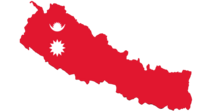Queen consort of Nepal
| Tripurasundari | |||||
|---|---|---|---|---|---|
| Queen consort of Nepal Queen regent of Nepal | |||||
 Portrait of Tripurasundari Portrait of Tripurasundari | |||||
| Born | 1794 | ||||
| Died | 6 April 1832(1832-04-06) (aged 37–38) Hanuman Dhoka Palace, Basantapur, Kathmandu | ||||
| Spouse | Rana Bahadur Shah | ||||
| |||||
| Dynasty | Shah dynasty (by marriage) Thapa dynasty (by birth) | ||||
| Father | Nain Singh Thapa | ||||
| Mother | Rana Kumari Pandey | ||||
| Religion | Hinduism | ||||

Tripurasundari (Nepali: रानी ललित त्रिपुरासुन्दरी; 1794 – 6 April 1832), also known as Lalit Tripura Sundari Devi, was a queen consort of Nepal by marriage to King Rana Bahadur Shah of Nepal. Widowed at a very young age and childless, she served as regent of the kingdom for a long period. She was regent for her stepson Girvan Yuddha Bikram Shah in 1806–1819, and for her step-grandson Rajendra in 1819–1832. She was the first woman to publish literature in Nepal.
Biography
Lalit Tripurasundari was born into an influential Nepali family to the feudal military elite of the kingdom. It is generally believed that Tripurasundari was from a Thapa family, and Baburam Acharya conjectured that Tripurasundari was possibly the daughter of Bhimsen Thapa's brother Nain Singh Thapa. Her siblings included Mathabarsingh Thapa (sometime Prime Minister of Nepal) and Ganesh Kumari Devi, the mother of Jung Bahadur Rana who founded the Rana hegemony over Nepal which lasted over 100 years (1846–1950).
In 1805 or 1806, Tripurasundari married the king of Nepal, Rana Bahadur Shah. This was an intercaste marriage, between the king (a Thakuri), and herself (a Chhetri), which was possible due to Bhimsen Thapa's growing influence and power. She was the youngest wife of the king. At the time, Bahadur Shah was serving as mukhtiyar (executive) for his son and successor, Girvan Yuddha Bikram Shah. One year later, Rana Bahadur Shah was assassinated by his half-brother. Tripurasundari and Rana Bahadur Shah did not have children.
Regency
After Rana Bahadur Shah was assassinated in 1806, Queen Rajeshwari, who acted as the regent for her stepson Girvan Yuddha Bikram Shah, was forced to commit sati. As such, Tripurasundari became the regent for their stepson. Girvan Yuddha Bikram Shah died in 1816, before he could take power, and his infant son Rajendra became the king. Tripurasundari also served as regent during the minority of Rajendra.
She was a staunch supporter of Bhimsen Thapa, who may have been her relative. As the acting regent, she influenced Bhimsen's position as the Prime Minister of Nepal for over 31 years from 1806 to 1832. During her regency for Girvan Yuddha, Tripurasundari issued a mandate that all members of the court must obey Bhimsen.
She died of cholera on 6 April 1832, during a widespread cholera epidemic in Kathmandu. She died the same year that Rajendra ascended to power, and her death decreased Bhimsen's political control.
Literary works
Tripurasundari was the first woman to publish literature in Nepal. She translated some parts of Shantiparva from the Sanskrit Mahabharata into Nepali and published it as Rajdharma, a treatise on the duties and responsibilities of a king, in 1824. Rajdharma has been praised by historians as "a credit to Nepal's language and literature."
She had also written many other poems in Nepali. She also encouraged writers and poets in her court, and, with her encouragement, her stepson Girvan Yuddha Vikram and step grandson Rajendra Vikram each wrote three books.
Structures and monuments
The construction of Dharahara was commissioned by either Tripurasundari or Bhimsen Thapa on her behalf. The tower collapsed in the 2015 Nepal earthquake, and now has been reconstructed. She also commissioned the Tripureshwor Mahadev temple at Tripureshwor and the bridge between Kathmandu and Lalitpur at Thapathali.
References
Citations
- Karmacharya 2005, p. 86.
- Acharya 2012, p. 3.
- Acharya 2012, p. 62.
- ^ Ācārya, Bāburāma (2012). Janarala Bhīmasena Thāpā : yinako utthāna tathā patana 2069. Kr̥shṇa. Ācārya (Saṃskaraṇa 1 ed.). Kāṭhamāḍaum̐: Śrīkr̥shṇa Ācārya. ISBN 978-9937-2-4174-8. OCLC 837563659.
- ^ Hutt, Michael (24 June 2019). "Revealing What Is Dear: The Post-Earthquake Iconization of the Dharahara, Kathmandu". The Journal of Asian Studies. 78 (3): 549–576. doi:10.1017/S0021911819000172. ISSN 0021-9118. S2CID 165687047.
- ^ Whelpton, John (1987). Nepali politics and the rise of Jang Bahadur Rana, 1830–1857 (PhD thesis). SOAS University of London. doi:10.25501/soas.00028837.
- A., Raj, Prakash (1997). Queens of the Shah Dynasty in Nepal. Nabeen Publications. OCLC 607611005.
{{cite book}}: CS1 maint: multiple names: authors list (link) - ^ Whelpton, John (2005). A history of Nepal. Cambridge: Cambridge University Press. ISBN 0-521-80026-9. OCLC 55502658.
- Nepali, Chitranjan (1965). General Bhimsen Thapa ra Tatkalin Nepal. Kathmandu: Ratna Pustak Bhandar. pp. 38–39.
- Rose, Leo E. (8 January 2021). Nepal: Strategy for Survival. Univ of California Press. ISBN 978-0-520-33868-5.
- Pokhrel, Shanta (1982). Nepalese Women. Ridhi Charan Pokhrel.
- "Video: 19th century tower collapses from earthquake in Nepal – Telegraph". 25 April 2015. Archived from the original on 25 April 2015. Retrieved 20 July 2021.
- Hamal, Nikki (15 January 2018). "KU rebuilding quake-damaged Tripureshwor Mahadev temple". The Himalayan Times. Retrieved 20 July 2021.
Bibliography
- Acharya, Baburam (2012), Acharya, Shri Krishna (ed.), Janaral Bhimsen Thapa : Yinko Utthan Tatha Pattan (in Nepali), Kathmandu: Education Book House, p. 228, ISBN 9789937241748
- Karmacharya, Ganga (2005), Queens in Nepalese politics: an account of roles of Nepalese queens in state affairs, 1775–1846, Kathmandu: Educational Pub. House, p. 185, ISBN 9789994633937
- Yadav, Pitambar Lal (1996). Nepal ko rajnaitik itihas. Benaras: Modern Deepak Press. p. 142.
- 1794 births
- 1832 deaths
- 18th-century Nepalese nobility
- 19th-century Nepalese nobility
- 19th-century poets
- 19th-century women regents
- 19th-century regents
- 19th-century women writers
- Bagale Thapa
- Deaths from cholera
- Nepalese Hindus
- Queens consort of Nepal
- Nepalese women poets
- 19th-century Nepalese women writers
- 19th-century Nepalese writers
- Nepali-language writers
- People of the Nepalese unification
- Thapa dynasty
